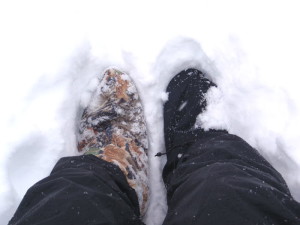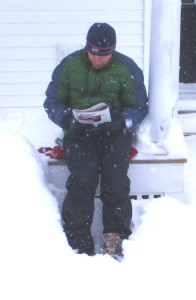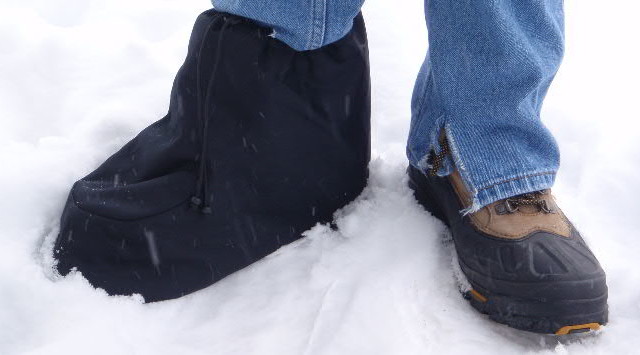Given how we constantly use DryGuy’s “Boot Gloves” when downhill skiing, it’ll probably come as no surprise that I use a similar product when I’m off the boards. For years, I’ve had some big puffy things that go over my boots and add an insulating layer when I’m not moving…for instance, when I’ve been snowshoeing or XC skiing and stop for lunch. However, they’re far from perfect…relatively heavy, and take up a LOT of space in my pack. So, when I ran across Arctic Shield Arctic Shield Boot Insulators,, which actually aren’t insulators, I had to try them!

First, some background. Arctic Shield’s claim to fame is something called “Re-tain”. Rather than being insulation in the traditional sense, it’s a waterproof/breathable fabric that also acts as a radiant barrier. In other words, rather than trying to trap your body heat, it reflects it back at you. That means that the product can be remarkably thin and still effective…at least in theory. And, we’ve had good luck with another DryGuy product, the ThermoFeet, which is a radiant barrier as well. Time to test them and find out for myself.
The boot covers themselves are a thin, well made black item with a zipper back and drawstring top. No significant sole on the bottom; they’re meant for standing or sitting around, not for walking in. They weigh about 25% less than my old boot covers, and take up about half the space. They’re definitely easier to pack, and the ounces saved are always welcome. Fit is fairly snug; they’re designed to go over thin boots, not heavily insulated ones. My feet are about a 10, and these had room for my Columbia Bugaboots and not much more.

It happened that we were headed off on a winter camping trip to test a bunch of products when they arrived, so into my pack they went. Test one was patently unfair. I’ve got some Sierra Designs down booties that are designed to be camp moccasins, fitting snugly around my feet. Taking a cover that’s designed to go over a boot and sticking my stocking foot inside isn’t reasonable…there’s a huge amount of air space inside. But, there’s no reason to not push them way beyond their design. At first, my foot inside the Arctic Shield was distinctly colder than in the down bootie…gee, shocking. A half hour later, though, I realized that there really wasn’t much difference in temperature; the comfort wasn’t there, since it wasn’t designed for my bare foot, but at least my tootsies were warm!
Test two was more “normal”. Hang around outside with one foot in just my Bugaboots, one with the Arctic Shield over it. Obviously, the foot with both covers was warmer…but also important was that the boot insulator was easy to walk around in (for limited distances…remember, these are NOT intended for extended walking). My old boot covers always felt squirrelly; they moved on the bottom of my feet and made me feel unstable. Chalk up two wins for Arctic Shield.
The final test was to put the Arctic Shield Boot Insulators on one foot, my old boot covers on the other. This seemed a little unfair to the AS covers, as the others are snug fitting; less air around the boots to warm up, so it would take longer for them to work. And, sure enough, within seconds there was an obvious difference between the two…but NOT what I was expecting. The Arctic Shield felt almost like there was an electric element in the boot cover…my entire foot, top and bottom, was surrounded in a cocoon of warmth. My old boot covers did a creditable job, but it was several minutes before I started to notice warmth building up. After about 10 minutes, indoors, there was virtually no difference between the two. But, that’s not real world. Luckily, there was a howling blizzard going on outside, so onto the front porch I went. If nothing else, I’d give the neighbors something to laugh about. It was cold enough that I put on my warmest Sherpa down jacket windproof overpants…and out I went. After 15 minutes, both feet felt perfectly comfortable. After 30, both were still warm…but on the foot with my old boot cover, I could feel the beginnings of a chill around my smaller toes. After 45 minutes, the difference was distinct, and my foot in the Arctic Shield boot cover wasn’t showing any signs of cold.

There aren’t a lot of contenders in this arena; boot covers aren’t a sexy product. The average person probably never thinks about them, never puts them on a Christmas list. But I don’t know of anything that can make a backpacking trip, a snowshoeing lunch, or even sitting in the bleachers at a football game miserable more quickly than cold feet. I got frostbitten as a kid, and my feet are always cold as a result, so I pay more attention to this area than most people. And I can say that, until someone shows me something better, the Arctic Shield Boot Insulators are going into my pack. I haven’t used them long enough yet to be positive, but something tells me that it won’t be long before you’ll see these categorized under “Our Favorite Things”!
UPDATE, 1/21/2010: I just happened to have a winter camping trip on the agenda, so took the Arctic Shields with me. Perfect weather for a trip…in the 20s during the day, down to 10 during the night. Rather than take my down booties at all, I just used the AS covers over my lightweight boots. In the morning, when it was coldest, I spent a couple of hours standing around on the snow, and my feet remained toasty warm. And, even with a long evening of sitting around after snowshoeing, when there was a lot of moisture in my boots to begin with, my feet didn’t get clammy or cold. Just one more situation where they passed a test with flying colors!


